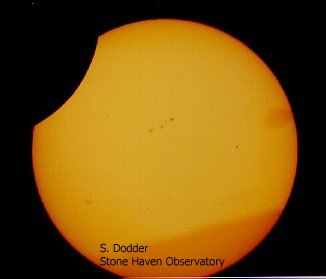
|
The last half of the extremely partial solar eclipse of 12/25/00. Two cameras
were employed-one loaded with ISO 400 slide film, the other with ISO 400 print film, both
from Kodak. Unfortunately, the print film camera malfunctioned by not advancing the film
when wound, so the first half of the eclipse is missing. It was captured on slides, however.
Cameras were alternated and an exposure taken every 5 minutes, making the interval 10
minutes for each media type. The entire event took just under 2 hours. It was really cool,
despite the barely covered sun! |

|
The last half of the extremely partial solar eclipse of 12/25/00 |

|
The last half of the extremely partial solar eclipse of 12/25/00 |

|
The last half of the extremely partial solar eclipse of 12/25/00 |
 |
The setup used to observe and photograph the extremely partial solar
eclipse of 12/25/00. From L - R, 4.5" F/4.5 solar scope used by yours truly to monitor progress
of the moon across the sun, the "Pieramyd" mount with C8 and camera used to take these shots,
through which is visible the table holding the radio set for WWV time signal, solar filter
glasses, coffee cup etc, chair used for centering sun in FOV, the 6" F/4.4 solar scope on an
English Yoke mount used by Rosie for observing the event and the adjustable observing chair
described elsewhere. |
 |
This was taken during the latest rotation-I'm not
quite sure what day it was. It clearly shows several really HUGE groups of sunspots.
One across the
Northern tropics stretches across 1/5 the solar diameter! I think the exposure was
around 1/125th second on Kodak Gold 400 ISO print film at the Cassegrain focus of the C8
in Stone Haven Observatory. |
 |
This is an eyepiece projection showing all the
major groups visible at the time. Note the faculae (brightening)
visible around the group on the right hand side of this image. Exposure was EPP through
the 25mm for 1/60th second. |
 |
Closeup of the largest group. I'd estimate this
group to stretch for nearly 175,000 miles across the surface. That's almost as far as
it is to our moon! |
 |
This was taken at around 5:00 pm MST on July 5, 1999. As you can see, the sun is
much more active now, on its way to a maximum in the coming years. |
 |
Sunspot group taken at prime focus just before I
packed up for the Messier Marathon on March 13, 1999. |
 |
Sunspot group taken with eyepiece projection at about
200X just before I packed up for the Messier Marathon on March 13, 1999. |
 |
Sunspot group taken with eyepiece projection at about
350X just before I packed up for the Messier Marathon on March 13, 1999. |
 |
Here's a neat shot of a sunset through my solar filter. One afternoon, I was dusting
the telescope tube as the scope sat on the tripod in my hallway. I happened to notice
the sun shining on it and decided to put the filter on and see what I could see. Well,
this is the view I was greeted with, so I decided to set up the scope the next day and
take this shot. If you look closely, you can see a sunspot group just above the center
of the sun's disk. Turned out kinda nice, huh? |
 |
This was an eyepiece projection of a nice sunspot
group. I liked the details I could see through the eyepiece and I'm fairly happy with
the way this shot turned out. |





 Page URL: http://www.stargazing.net/Astroman/Solar.html
Page URL: http://www.stargazing.net/Astroman/Solar.html